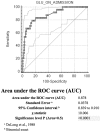Statistical and clinical analysis of alterations in glucose values after burns
- PMID: 28149243
- PMCID: PMC5266231
Statistical and clinical analysis of alterations in glucose values after burns
Abstract
The purpose of this study was to evaluate independent factors (mainly critical hyperglycaemic values on admission) with an impact on outcome in burn patients (sepsis and mortality) and analyse prevalence of critical hyperglycaemia on admission and during burn disease in adult and elderly patients with severe burns. This was an observational retrospective cohort study involving burn patients (≥ 20 years old) hospitalized in the ICU of the Burn Facility in Albania during 2010-2014. Patients were categorized as having euglycaemia, moderate or critical hyperglycaemia. Regression analysis, hyperglycaemia prediction test and risk measurement were performed for the population. Statistical significance for SIH was only found for glucose values on admission, presence of diabetes and BMI. Using 180 mg/dl as cut off for critical hyperglycaemia, we found that this test had a sensitivity of 66.67% (95% CI: 44.68% to 84.33%), specificity of 88.20% (95% CI: 84.16% to 91.51%), PPV of 29.63% (95% CI: 17.99% to 43.61%) and NPV of 97.26% (95% CI: 94.67% to 98.81%). Statistical significance was found for patients with critical hyperglycaemia on admission regarding relative and absolute risk measures for sepsis and mortality. Glucose values on admission, as one of the derangement features of burn shock, are prognostic factors in critical hyperglycaemia during disease, and have a close relationship with other outcomes (sepsis and mortality).
L’objet de cette étude est l’analyse des facteurs indépendants (essentiellement l’hyperglycémie à l’admission) ayant un impact sur le devenir des patients (sepsis et mortalité) ainsi que l’étude de la prévalence de l’hyperglycémie à l’entrée comme en cours d’hospitalisation chez des patients adultes (avec un sous-groupe de patients âgés) sévèrement brûlés. Il s’agit d’une étude rétrospective concernant des patients de plus de 20 ans hospitalisés dans lez service de réanimation pour brûlés albanais entre 2010 et 2014. Trois catégories de patients ont été définies: glycémie normale, modérément élevée, fortement élevée. Une analyse par régression a été effectuée pour évaluer la corrélation entre le devenir du patient et ses glycémies. Une corrélation avec l’hyperglycémie de stress a été trouvée en cas de glycémie élevée à l’admission, en cas de diabète et avec l’IMC. Un seuil de 180 mg/dL pour la définition d’une glycémie fortement élevée permet d’obtenir une sensibilité de 66,67% (IC95 44,68-84,33%), une spécificité de 88,2% (IC95 84,16-91,51%), une valeur prédictive positive de 29,63% (IC95 17,99-43,61) et une valeur prédictive négative de 97,26% (IC95 94,67-98,81%). Il existe une association statistiquement significative entre l’hyperglycémie à l’entrée et la morbi-mortalité. Une hyperglycémie initiale est un facteur pronostic défavorable, en termes de complications infectieuses et de moralité, chez les patients gravement brûlés.
Keywords: SIH; burns; hyperglycaemia; sepsis.
Figures







Similar articles
-
[Retrospective cohort study on the correlation between high value of lactic acid and risk of death in 127 patients with extensive burn during shock stage].Zhonghua Shao Shang Za Zhi. 2019 May 20;35(5):326-332. doi: 10.3760/cma.j.issn.1009-2587.2019.05.002. Zhonghua Shao Shang Za Zhi. 2019. PMID: 31154729 Chinese.
-
Long term mortality in critically ill burn survivors.Burns. 2017 Sep;43(6):1155-1162. doi: 10.1016/j.burns.2017.05.010. Epub 2017 Jun 9. Burns. 2017. PMID: 28606748
-
Associations of Diabetes and Hyperglycaemia with Extent and Outcomes of Acute Burn Injuries.Biomedicines. 2024 May 19;12(5):1127. doi: 10.3390/biomedicines12051127. Biomedicines. 2024. PMID: 38791089 Free PMC article.
-
[Clinical significance of continuous thrombocytopenia in predicting sepsis after severe burn].Zhonghua Shao Shang Za Zhi. 2014 Aug;30(4):295-8. Zhonghua Shao Shang Za Zhi. 2014. PMID: 25429806 Chinese.
-
Glucagon orchestrates stress-induced hyperglycaemia.Diabetes Obes Metab. 2016 Jul;18(7):648-53. doi: 10.1111/dom.12668. Epub 2016 May 4. Diabetes Obes Metab. 2016. PMID: 27027662 Free PMC article. Review.
References
-
- Mizock BA. Alterations in fuel metabolism in critical illness: hyperglycaemia. Best Pract Res Clin Endocrinol Metab. 2001;15:533–551. - PubMed
-
- Van den Berghe G, Wouters P, Weekers F, Verwaest Ch. Intensive insulin therapy in critically ill patients. N Engl J Med. 2001;345:1359–1367. - PubMed
-
- Finfer S, Chittock DR, Su SY, Blair D. Intensive versus conventional glucose control in critically ill patients. N Engl J Med. 2009;360:1283–1297. - PubMed
-
- Dellinger RP, Levy MM, Rhodes A. Surviving sepsis campaign: International guidelines for management of severe sepsis and septic shock: 2012. Crit Care Med. 2013;41:580–637. - PubMed
LinkOut - more resources
Full Text Sources
